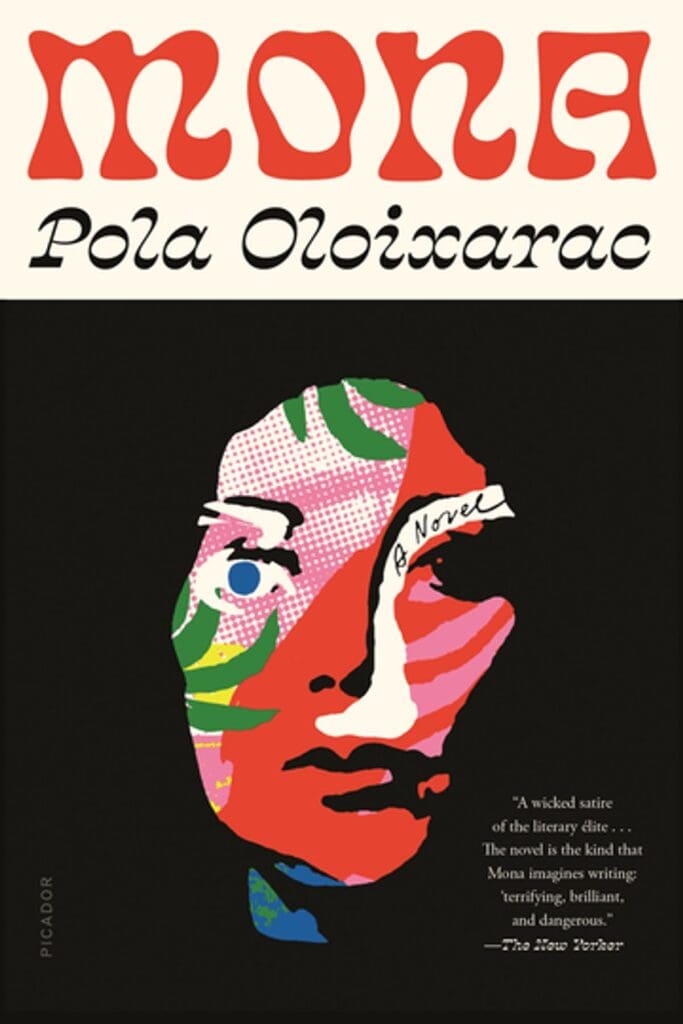“The festivals are the real novels!” shouts the protagonist of Mona (192 pages; FSG Books), a new novel by Argentinian author Pola Oloixarac. Mona is one-whiskey-deep, standing in a pub in Sweden with a crowd of writers. Across the bar, a Latvian poet grabs a Finnish author, striking up a conga line. Mona orders a second whiskey and surveys the crowd. “They come to places like these thinking they’re writers,” she continues, “and end up leaving as characters.”
The occasion for this evening’s celebration, as well as the novel as a whole, is the ceremony for the Basske-Wortz Prize: a prestigious, fictional literary award whose pull has drawn a group of nominated authors—Mona included—to a Swedish lakeside town. Here, a simple agenda awaits: a few days of speeches and small talk, culminating in the crowning of this year’s winner. “Come thirsty,” the event invitation reads, “and bring an appetite for Nordic delicatessen!”
In many ways, Mona is the festival-novel described by its protagonist’s tipsy epiphany—head-deep in the less-than-nice niceties of the international literary circuit. But as much as the novel delights in self-referential jabs at the state of contemporary letters (and there are many), the real rewards of this curious, compelling book lie with the mysterious Mona, and the questions that gather around her. What is she feeling? What’s with the missed calls flooding her phone? And why is she unable to recall the cause of the bruises that appear, bright and wincing, across her skin?
Certain things about Mona—or, rather, Mona’s impressive CV—are clear from the start. Something of a rising star in the Latin American literary scene, her career has been buoyed by waves of praise for her debut novel. (“A radical phenomenon,” critics call her). Completing her Ph.D. at Stanford, Mona claims the status of a “savior holding down the front lines of literature.” And now, the Basske-Wortz nod: a prize that would confer upon her significant cultural capital, along with a good deal of actual capital—a €200,000 cash prize.
As for the character peering out from beneath this pile of accolades—well, there’s the enigma. Oloixarac offers few details about Mona’s interiority, instead choreographing her movements, while draping her in external descriptions. Often, the novel lingers on the appeal of Mona’s appearance, rendered—via Adam Morris’ translation from the Spanish—with a logician’s rigor. (Mona wears “gray jeans cinched with a pleather belt to accentuate her waistline—and therefore, her booty.”) And then there’s the matter of the bruises, as Mona wakes, in the first chapter, to a “violet blotch spreading across her neck.”
Before there’s time to ask how it got there, Mona has taken a Valium, boarded her plane, and arrived in Sweden. Here, the novel riffs eagerly on its preferred comedic target: the pretenses and pressures of the literary world. Mona is wary of the cultural expectation to view certain facts of an author’s identity—gender, nationality—as stand-ins for their writerly essence. For Mona (and, one suspects, Oloixarac as well) this smacks of a kind of reductive, zoological categorization—one that strips writers of their selfhood. The novel plays all this up, opting to refer to nominees in national shorthand: the Swedish nonfictionalist, the Japanese writer, the Macedonian author. Early on in the festival, an Armenian poet briefly goes missing. When asked for information to help with the search, another writer shouts back: “How should I know what he looks like? He looks like an Armenian poet!”
The festivities soon begin. Each writer shares some prepared words, allowing the novel to air out various arguments about the role of literature in the twenty-first century. Some nominees see their duty along classical, humanist parameters. (An Iranian writer on his craft: “That’s why I write, even today: to give voice to the people who have only known silence.”) Others believe that new technologies have irrevocably fractured any possibility of a genuine author-audience bond. (“We have to accept,” says a Colombian author, “that our readers are no longer human.”)
As these debates unfold, Mona makes it clear that it, too, is implicated—its prose wriggling beneath characters’ claims about what a novel ought to be. Describing a tour through Stockholm, Oloixarac writes that “a coat of moisture covered the entire city, giving the cobblestones a cinematic luster.” By the next chapter, one of the nominated writers asks of another: “Is that a good thing now, in today’s literature—being cinematic?”
It would be easy for the sum of these meta-inserts to make Mona a book of artifice or brittle irony. But, fortunately, the twin hearts of the novelistic form—interiority, consciousness—at last begin to beat within our impenetrable Mona. When a fellow writer spots her cuts and bruises, Mona confesses, “it’s strange, but I have this memory that I died. I was dead.” Slowly, more recollections emerge, “shuffled like cards.” A highway at night. A man from her program at Stanford. His car, his place, the glass against her face.
When she finally remembers everything, the book takes a sharp tonal turn—submerging its previous pages beneath an apocalyptic, disastrous climax. As an ending, it’s both entirely unexpected and not wholly warranted. But with it, the significance of Basske-Wortz, as well as the literary drama of the past few days, fades swiftly away. What remains is Mona. She looks up at the sky “as though reality had always been waiting for her”—a character, and real, at last.

